warning RENAULT KANGOO 1997 KC / 1.G Engine And Peripherals User Guide
[x] Cancel search | Manufacturer: RENAULT, Model Year: 1997, Model line: KANGOO, Model: RENAULT KANGOO 1997 KC / 1.GPages: 208
Page 141 of 208
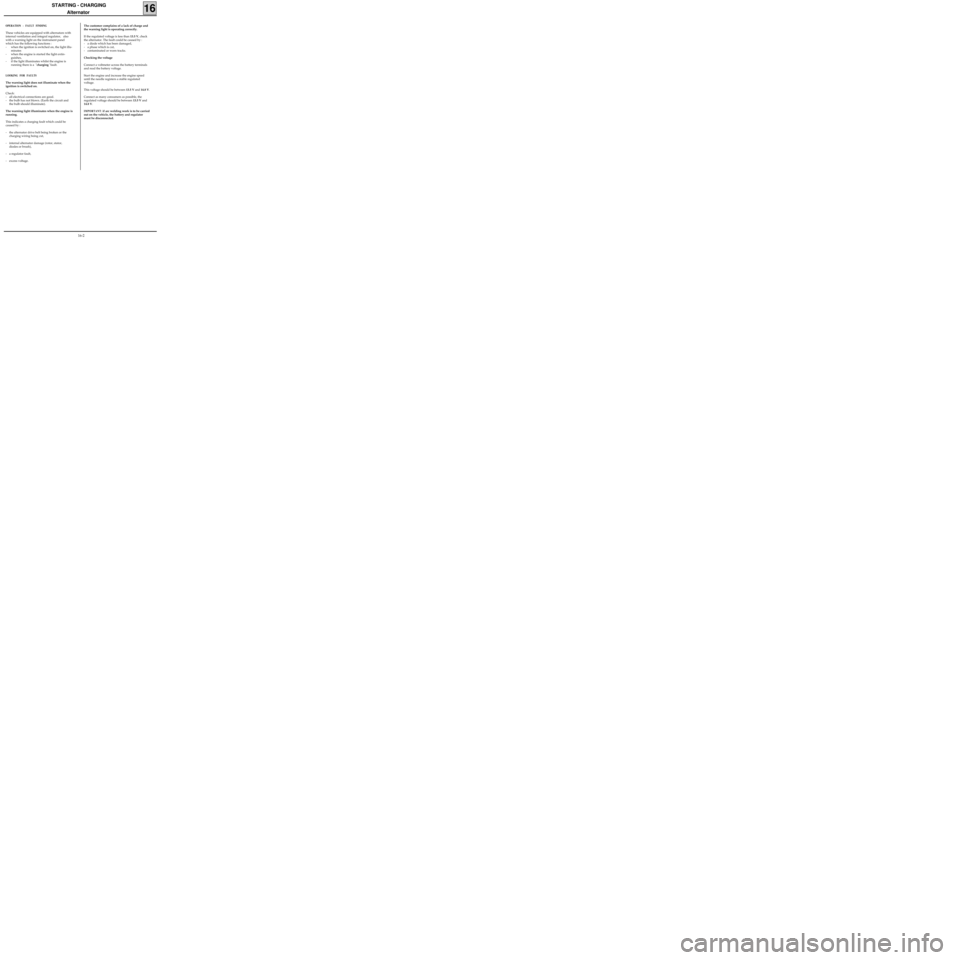
STARTING - CHARGING
Alternator
16
OPERATION - FAULT FINDING
These vehicles are equipped with alternators with
internal ventilation and integral regulator, also
with a warning light on the instrument panel
which has the following functions :
- when the ignition is switched on, the light illu-
minates
- when the engine is started the light extin-
guishes,
- if the light illuminates whilst the engine is
running there is a "charging "fault.
LOOKING FOR FAULTS
The warning light does not illuminate when the
ignition is switched on.
Check:
- all electrical connections are good.
- the bulb has not blown. (Earth the circuit and
the bulb should illuminate).
The warning light illuminates when the engine is
running.
This indicates a charging fault which could be
caused by :
- the alternator drive belt being broken or the
charging wiring being cut,
- internal alternator damage (rotor, stator,
diodes or brush),
- a regulator fault,
- excess voltage.The customer complains of a lack of charge and
the warning light is operating correctly.
If the regulated voltage is less than 13.5 V, check
the alternator. The fault could be caused by :
- a diode which has been damaged,
- a phase which is cut,
- contaminated or worn tracks.
Checking the voltage
Connect a voltmeter across the battery terminals
and read the battery voltage.
Start the engine and increase the engine speed
until the needle registers a stable regulated
voltage.
This voltage should be between 13.5 V and 14.8 V.
Connect as many consumers as possible, the
regulated voltage should be between 13.5 V and
14.8 V.
IMPORTANT: if arc welding work is to be carried
out on the vehicle, the battery and regulator
must be disconnected.
16-2
Page 154 of 208
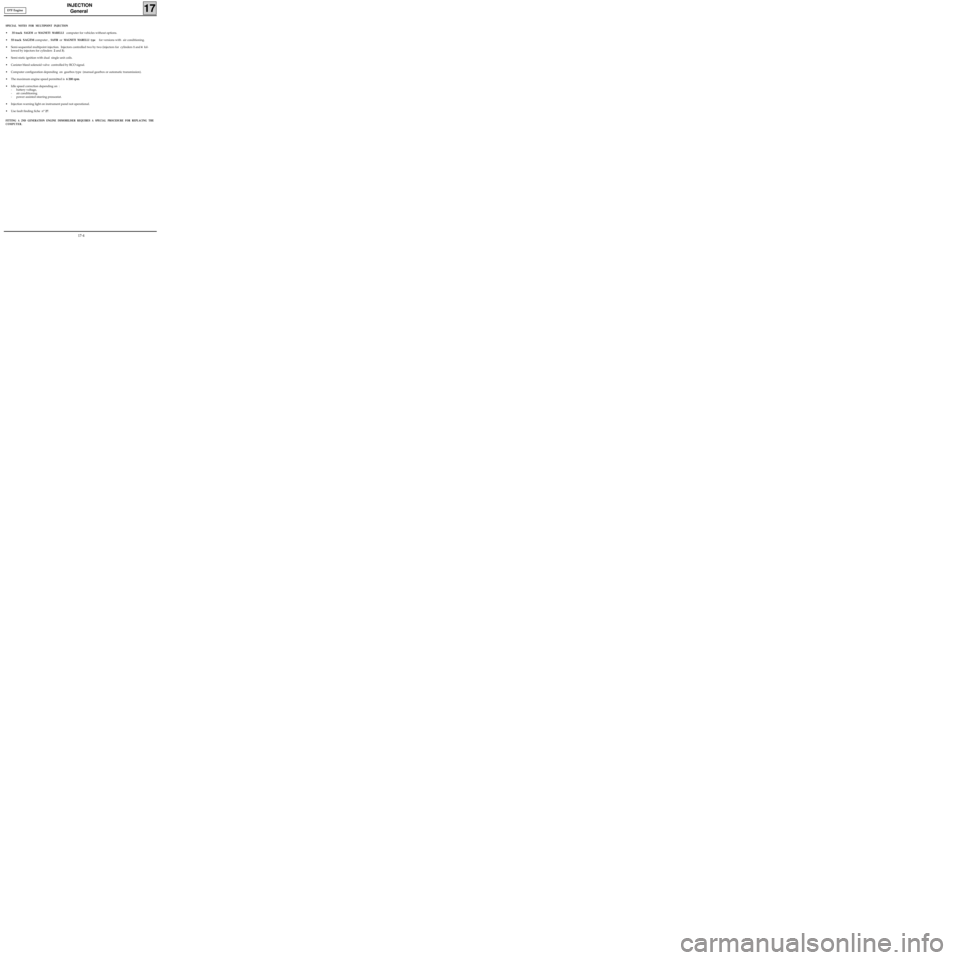
INJECTION
General
17
SPECIAL NOTES FOR MULTIPOINT INJECTION
• 35 track SAGEM or MAGNETI MARELLI computer for vehicles without options.
• 55 track SAGEM computer ,
SAFIR or MAGNETI MARELLI type for versions with air conditioning.
•Semi-sequential multipoint injection. Injectors controlled two by two (injectors for cylinders 1 and 4 fol-
lowed by injectors for cylinders 2 and 3).
•Semi-static ignition with dual single unit coils.
•Canister bleed solenoid valve controlled by RCO signal.
•Computer configuration depending on gearbox type (manual gearbox or automatic transmission).
•The maximum engine speed permitted is 6 200 rpm.
•Idle speed correction depending on :
- battery voltage,
- air conditioning
- power assisted steering pressostat.
•Injection warning light on instrument panel not operational.
•Use fault finding fiche n° 27. D7F Engine
FITTING A 2ND GENERATION ENGINE IMMOBILISER REQUIRES A SPECIAL PROCEDURE FOR REPLACING THE
COMPUTER.
17-4
Page 155 of 208
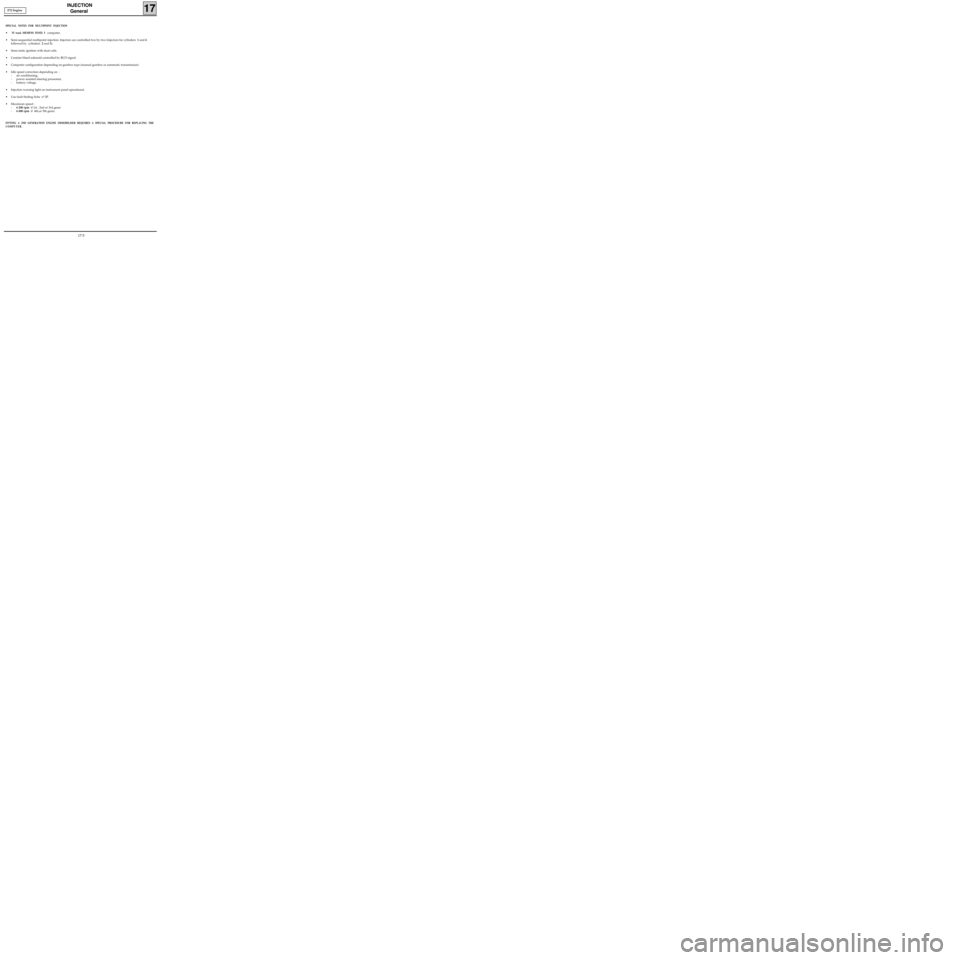
INJECTION
General
17
SPECIAL NOTES FOR MULTIPOINT INJECTION
• 55 track SIEMENS FENIX 5 computer.
•Semi-sequential multipoint injection. Injectors are controlled two by two (injectors for cylinders 1 and 4
followed by cylinders 2 and 3).
•Semi-static ignition with dual coils.
•Canister bleed solenoid controlled by RCO signal.
•Computer configuration depending on gearbox type (manual gearbox or automatic transmission)
•Idle speed correction depending on :
- air conditioning,
- power assisted steering pressostat,
- battery voltage.
•Injection warning light on instrument panel operational.
•Use fault finding fiche n° 27.
•Maximum speed :
-6 200 rpm if 1st , 2nd or 3rd gears
-6 000 rpm if 4th,or 5th gears. E7J Engine
FITTING A 2ND GENERATION ENGINE IMMOBILISER REQUIRES A SPECIAL PROCEDURE FOR REPLACING THE
COMPUTER.
17-5
Page 163 of 208
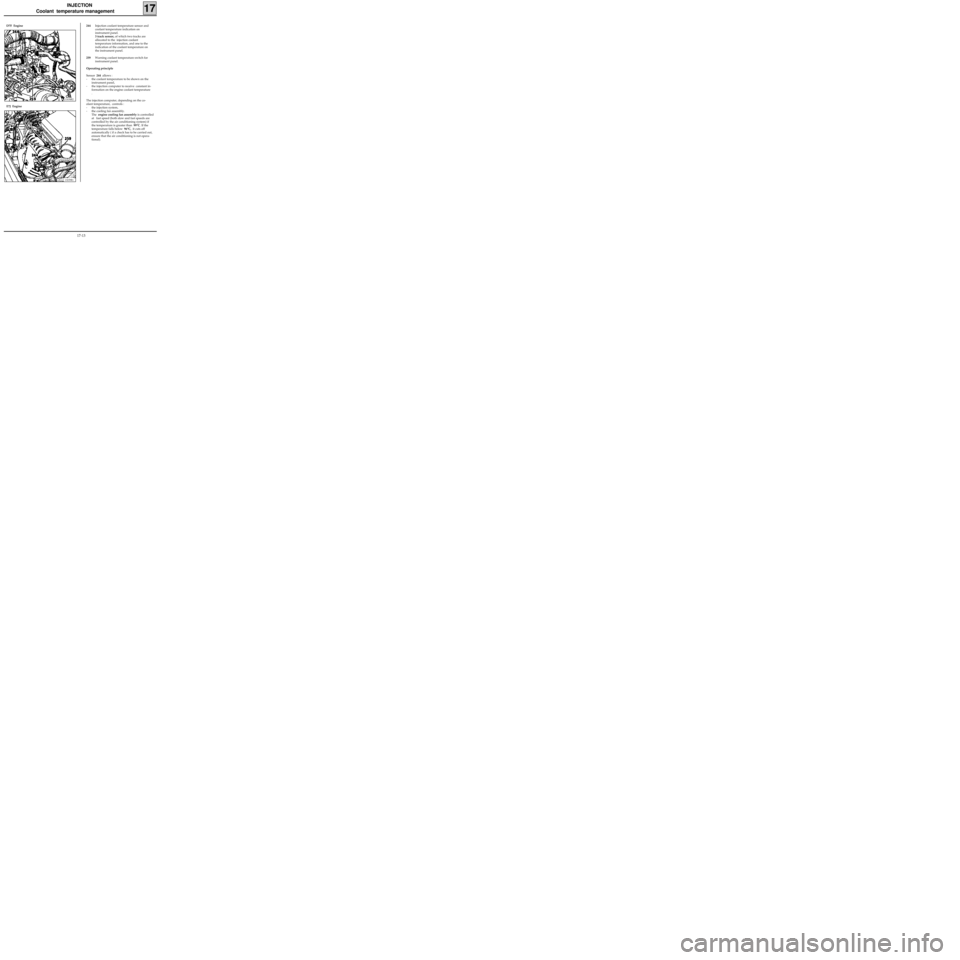
INJECTION
Coolant temperature management
244Injection coolant temperature sensor and
coolant temperature indication on
instrument panel.
3 track sensor, of which two tracks are
allocated to the injection coolant
temperature information, and one to the
indication of the coolant temperature on
the instrument panel.
259Warning coolant temperature switch for
instrument panel.
Operating principle
Sensor 244 allows :
- the coolant temperature to be shown on the
instrument panel,
- the injection computer to receive constant in-
formation on the engine coolant temperature
.
The injection computer, depending on the co-
olant temperature, controls :
- the injection system,
- the cooling fan assembly.
The engine cooling fan assembly is controlled
at fast speed (both slow and fast speeds are
controlled by the air conditioning system) if
the temperature is greater than 99°C. If the
temperature falls below 96°C, it cuts off
automatically ( if a check has to be carried out,
ensure that the air conditioning is not opera-
tional).
17
11634R2
D7F Engine
13239R1
E7J Engine
17-13
Page 164 of 208
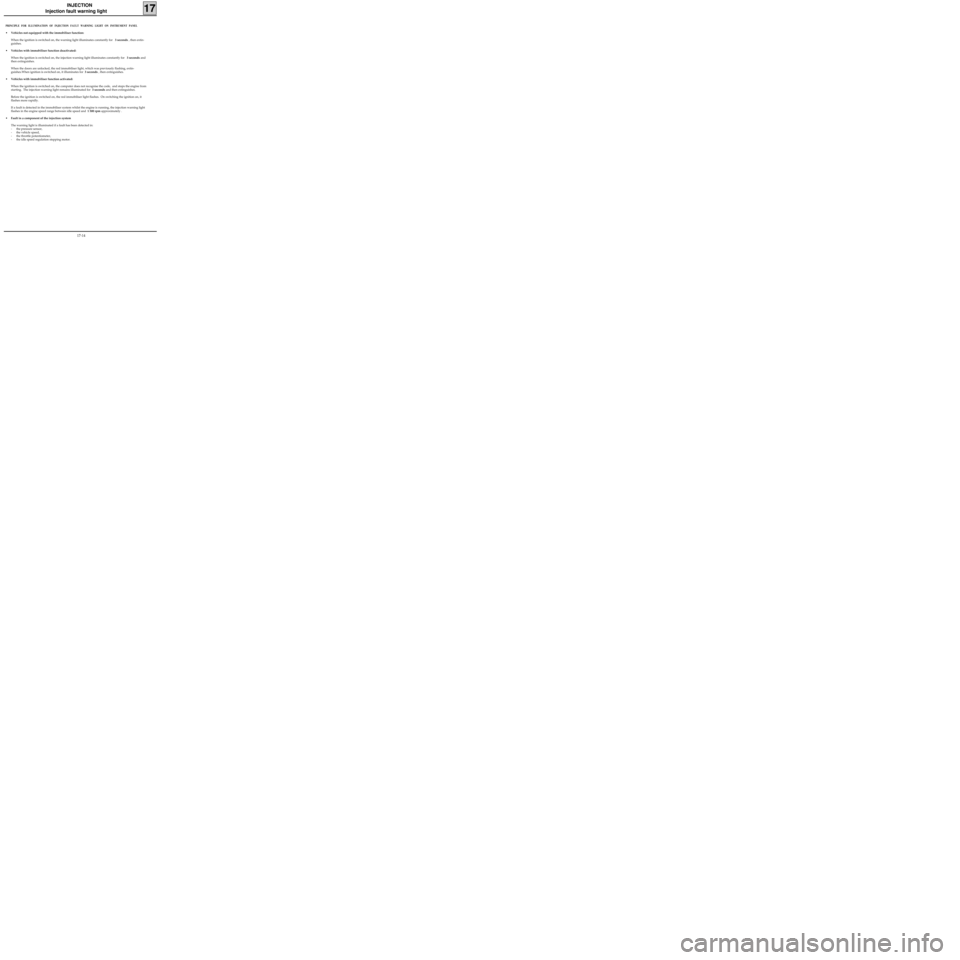
INJECTION
Injection fault warning light
17
PRINCIPLE FOR ILLUMINATION OF INJECTION FAULT WARNING LIGHT ON INSTRUMENT PANEL
• Vehicles not equipped with the immobiliser function:
When the ignition is switched on, the warning light illuminates constantly for 3 seconds , then extin-
guishes.
• Vehicles with immobiliser function deactivated:
When the ignition is switched on, the injection warning light illuminates constantly for 3 seconds and
then extinguishes.
When the doors are unlocked, the red immobiliser light, which was previously flashing, extin-
guishes.When ignition is switched on, it illuminates for 3 seconds , then extinguishes.
• Vehicles with immobiliser function activated:
When the ignition is switched on, the computer does not recognise the code, and stops the engine from
starting. The injection warning light remains illuminated for 3 seconds and then extinguishes.
Before the ignition is switched on, the red immobiliser light flashes. On switching the ignition on, it
flashes more rapidly.
If a fault is detected in the immobiliser system whilst the engine is running, the injection warning light
flashes in the engine speed range between idle speed and 1 500 rpm approximately .
• Fault in a component of the injection system
The warning light is illuminated if a fault has been detected in:
- the pressure sensor,
- the vehicle speed,
- the throttle potentiometer,
- the idle speed regulation stepping motor.
17-14
Page 165 of 208
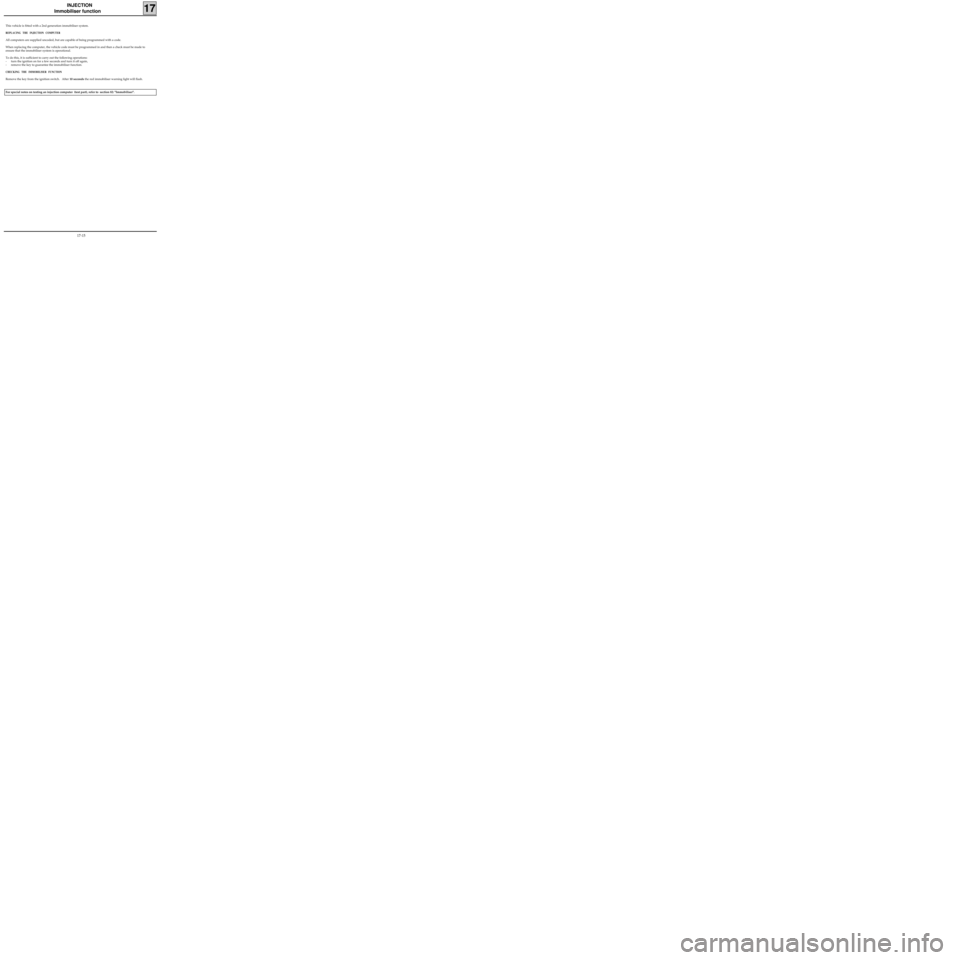
INJECTION
Immobiliser function
17
This vehicle is fitted with a 2nd generation immobiliser system.
REPLACING THE INJECTION COMPUTER
All computers are supplied uncoded, but are capable of being programmed with a code.
When replacing the computer, the vehicle code must be programmed in and then a check must be made to
ensure that the immobiliser system is operational.
To do this, it is sufficient to carry out the following operations:
- turn the ignition on for a few seconds and turn it off again,
- remove the key to guarantee the immobiliser function.
CHECKING THE IMMOBILISER FUNCTION
Remove the key from the ignition switch. After 10 seconds the red immobiliser warning light will flash.
For special notes on testing an injection computer (test part), refer to section 82: "Immobiliser".
17-15
Page 205 of 208
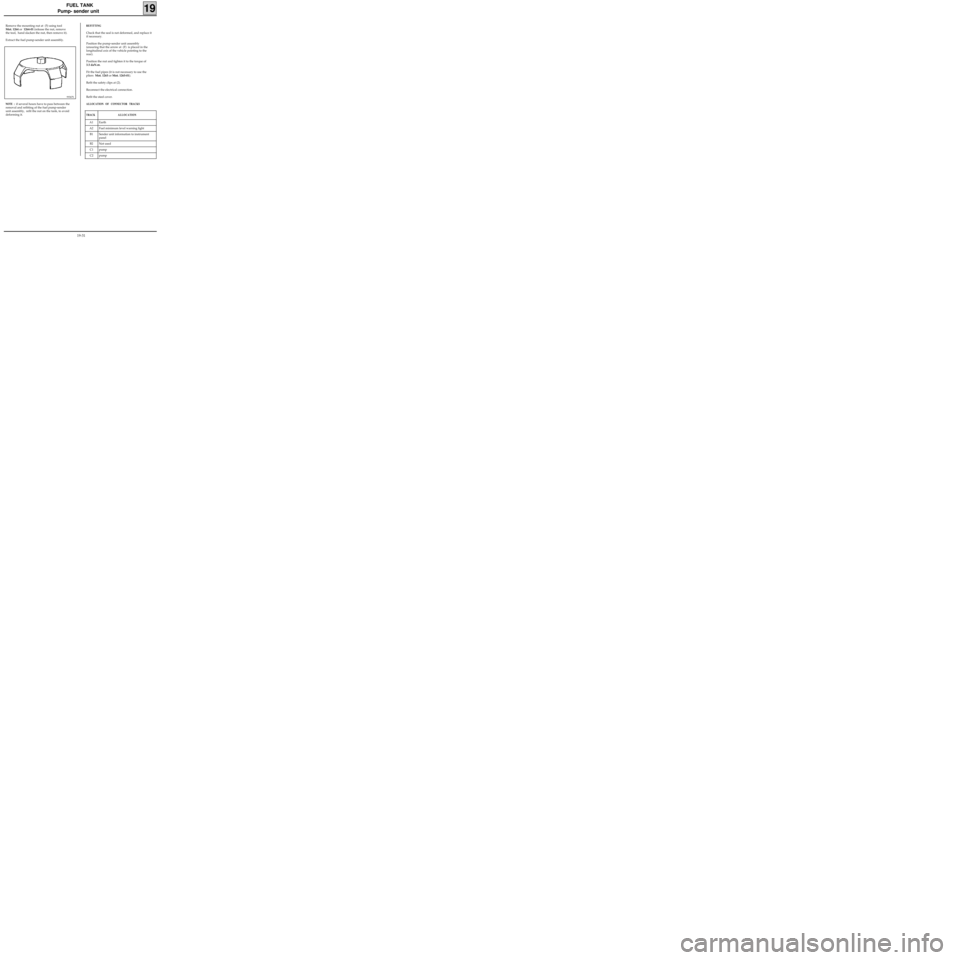
FUEL TANK
Pump- sender unit
19
REFITTING
Check that the seal is not deformed, and replace it
if necessary.
Position the pump-sender unit assembly
(ensuring that the arrow at (F) is placed in the
longitudinal axis of the vehicle pointing to the
rear).
Position the nut and tighten it to the torque of
3.5 daN.m.
Fit the fuel pipes (it is not necessary to use the
pliers Mot. 1265 or Mot. 1265-01).
Refit the safety clips at (2).
Reconnect the electrical connection.
Refit the steel cover.
ALLOCATION OF CONNECTOR TRACKS
TRACK ALLOCATION
A1 Earth
A2 Fuel minimum level warning light
B1 Sender unit information to instrument
panel
B2 Not used
C1 pump
C2 pump
Remove the mounting nut at (5) using tool
Mot. 1264 or 1264-01 (release the nut, remove
the tool, hand slacken the nut, then remove it).
Extract the fuel pump-sender unit assembly.
99367S
NOTE : if several hours have to pass between the
removal and refitting of the fuel pump-sender
unit assembly, refit the nut on the tank, to avoid
deforming it.
19-31